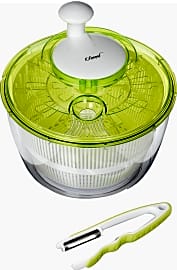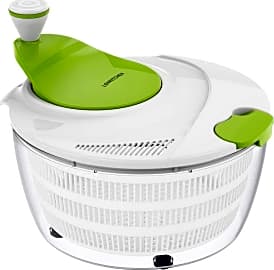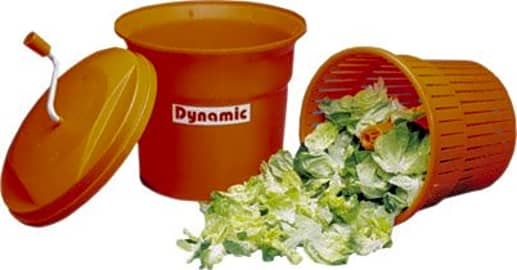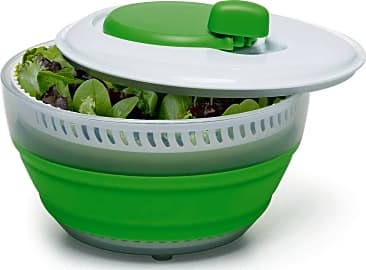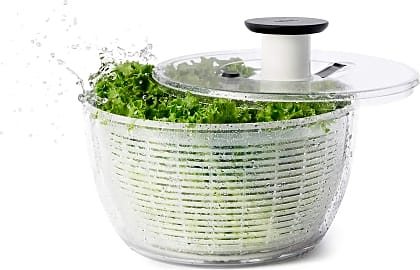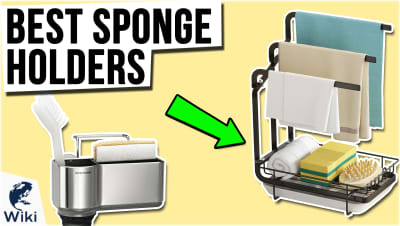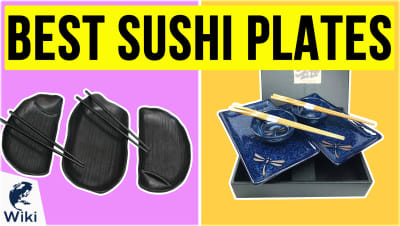The 10 Best Salad Spinners

This wiki has been updated 41 times since it was first published in March of 2015. Life’s too short to settle for limp, soggy salads. If you want the crunchiest, freshest-tasting leaves, give them a whirl in one of these handy salad spinners. Many of them will serve as a stylish addition to your kitchen, and the next time you sit down to tackle that healthy meal you’ve been craving, you won’t have to face the disappointment of wilted or browning greens. When users buy our independently chosen editorial choices, we may earn commissions to help fund the Wiki.
Editor's Notes
April 09, 2020:
To save you from soggy salad, we've kept a range of models that include both plastic and metal components. Coming out on top is the popular Mueller Smart Lock, which has plenty of usability features, including a brake button that can help save your valuable time. Guaranteed for life, it's crafted from robust plastic that will last, and it holds up to five quarts. The Savant Kitchen Jumbo has a similar capacity, despite its name, while the LovKitchen 4 Quart is a bit smaller. Both are fine plastic models for day-to-day use. As for metal options, there's the Rosle Stainless Steel, which has a metal outer salad bowl that will look elegant on any table. It's rather expensive, though.
For those who need something a little different, we've kept the Dynamic International, for commercial kitchens, and the Prepworks by Progressive Collapsible, for tiny ones. The latter collapses to about half its size for storage, but some usability is lost, making it a bit finicky. You might consider this model for occasional use only, sticking to heavier duty choices, like the Good Cook Deluxe, for daily service.
Finally, a word about the popular Oxo Good Grips Large. This sleek model is not without flaws, including a rather slow spinning rate that does not dry as well as could be hoped. For fans of the brand, and for those who are patient, it can be worth it, but if you're the type who is always in a hurry, you might want to give it a pass.
Special Honors
Matfer Bourgeat Swing 5 Gallon It's on the pricey side, but the Matfer Bourgeat Swing 5 Gallon feels strong and secure, even when filled to its capacity of four or five heads of lettuce. There's a drainage tube for your convenience, as well as a multi-gear system that reduces the amount of effort needed for effective use. matferbourgeatusa.com
Sammic ES-100 Commercial kitchens can rely on the Sammic ES-100, which can handle up to 10 gallons per cycle, each running at 900 RPM. And even though it's powerful, it feels secure in operation thanks to braking casters, automatic load distribution, and a strong aluminum base. sammic.us
Williams Sonoma Stainless-Steel The Williams Sonoma Stainless-Steel combines a metal basket with a sturdy plastic bowl that's BPA-free for your peace of mind. It has plenty of features to make using it a breeze, including a highly efficient gear system and a stop button that only requires one touch. williams-sonoma.com
A Brief History Of The Salad Spinner
While it had a few predecessors dating back as far as the 19th century, the salad spinner as we know it today dates back to the 1970s.
While it had a few predecessors dating back as far as the 19th century, the salad spinner as we know it today dates back to the 1970s. Two French designers, Jean Mantelet and Gilberte Fouineteau, each filed patents for early iterations of the device in 1971 and 1973, respectively. In 1974, the Mouli Manufacturing Company introduced the first crank-operated salad spinner to American consumers.
Before that, many people used wire baskets to dry lettuce and other vegetables. Once the produce inside it was washed, consumers shook the basket vigorously in order to remove some of the remaining water. Unfortunately, this commonly resulted in the user being doused with water droplets, as there was no way to contain the runoff. There were also wire lettuce driers that attached to sinks with suction cups and could be spun manually or with a hand-operated pump, but these caused the same wetness problem.
The first salad spinners were introduced in part to address the water-spray issue. They featured a two-chambered design to contain the runoff. The fully-enclosed strainer basket with a crank-powered spinning mechanism also worked to make its contents considerably more dry than any solution that had come before it, and in less time, too.
The Mouli spinners sold in America closely resembled Fouineteau's designs, most notably for their removable internal baskets and lack of a central post. This allowed for its contents to be washed and dried in the same bowl, and also made the entire device easier to clean. The product was immediately successful, with many stores struggling to keep up with demand.
Some customers complained that the spinners were difficult to store, and many critics believed them to be a passing fad like so many kitchen gadgets that came before. Despite those drawbacks and predictions, sales continued to climb throughout the 70s, with an estimated 500,000 units sold in 1978.
Over time, smaller versions were introduced to dry things like herbs. Various improvements were also made to the crank-based design, including versions with pull-cords, push-buttons, and electrically powered mechanisms. The technology hasn't changed much since that first decade, but the devices remain a staple in homes around the world.
The Science Behind The Spin
The basic principle behind the function of a salad spinner is centrifugal force. Have you ever been on one of those amusement park rides where you get strapped to the wall of a circular space, which then begins to spin? Once it reaches a certain speed, the floor drops out from beneath you, but you don't fall to the ground. Instead, centrifugal force keeps you pinned to the wall.
That's basically what's going on inside of a salad spinner. Centrifugal force is an apparent outward force that acts on a body moving around a central point. It's the same thing that you feel when you're inside of a car that's moving quickly along a curve. If the road is curving left, your body feels like it's getting pushed to the right, and vice versa. If the car stayed on that curve forever, it would eventually make a circle, and your body would get pushed away from the circle's central point by centrifugal force.
In a salad spinner, each piece of lettuce is a body on which centrifugal force acts, and each water molecule is, as well. The lettuce gets pressed up against the edges of the internal strainer because it's too large to move past it. The water, on the other hand, can keep moving outward, and it does, which leaves your lettuce nice and dry.
Why A Salad Spinner Is Important, And What Else You Can Do With It
To state the obvious, no one likes a wet salad. But there are two important reasons that go beyond personal preference that make spinning your salad a necessity. The first is that most salad dressings are oil-based. Water repels oil, and so salad greens covered in water will repel dressing. This will result in the dressing pooling at the bottom of your salad bowl instead of coating the greens.
The next time you need to wash berries, broccoli, green beans, or mushrooms, try using a salad spinner.
The second reason to remove water from your salad is to retain its freshness. The more moisture that's in your salad, especially if you're not dressing the whole thing at once, the more quickly it will go bad. The leaves will turn brown and everything will lose its crisp texture if it sits in excess moisture. If you're not planning on consuming all of your salad immediately, make sure each of its components is as dry as possible before combining them.
If those two essential warnings against wet greens have not convinced you that you need a salad spinner in your life, fear not, there are plenty of other reasons to get one. Many people think of salad spinners as one-trick ponies that only serve a single purpose and otherwise occupy more than their fair share of precious space in your home, but they actually have quite a number of alternate uses.
Salad spinners are useful for washing and drying a wide variety of fruits and vegetables. They are ideal because you can wash and dry things in a single container, and the spinning action they use is delicate enough that it won't damage or bruise your produce. The next time you need to wash berries, broccoli, green beans, or mushrooms, try using a salad spinner. You're sure to delight in how dry its contents become, and how quick and easy it is to use.
You can also use the internal compartment of your salad spinner as a colander for fresh-cooked pasta. If you're making a cold dish like pasta salad, spinning the noodles to remove the excess starchy water will cool them more quickly and also help keep them from sticking together.
The basket is also great for defrosting meat and drying before cooking. Vegetables from which it is good to remove excess moisture before frying like zucchini, eggplant, and shredded potatoes, can also be dried in a salad spinner, rather than squeezed out by hand. It also works well as a small dryer for hand-washed delicates.


